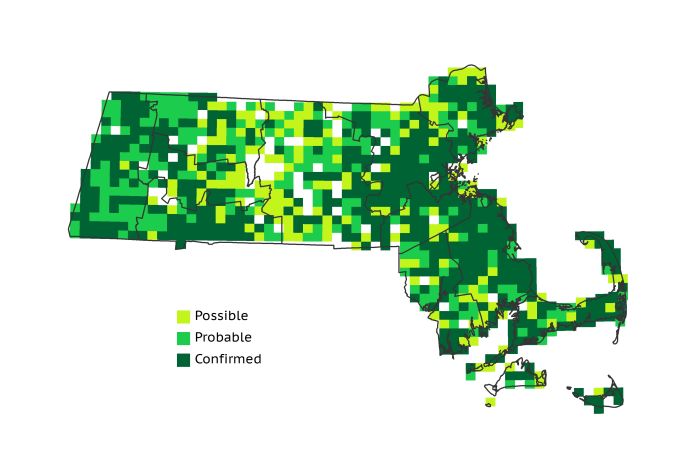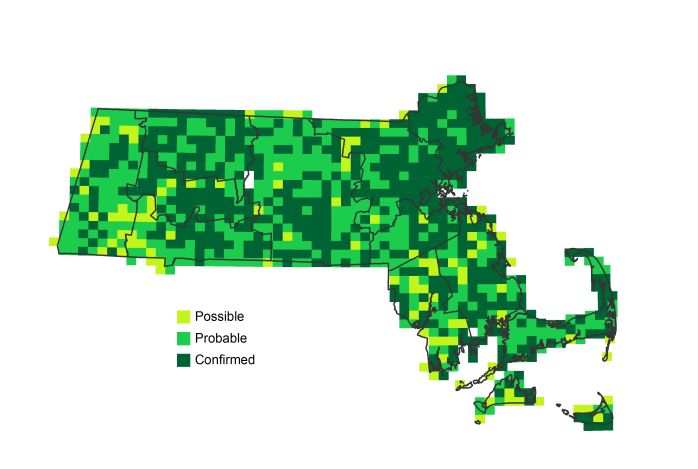Find a Bird
Mourning Dove
Zenaida macroura

Nearly ubiquitous and stable
“I had a dove and the sweet dove died; / And I have thought it died of grieving: / O what could it grieve for? Its feet were tied, / With a silken thread of my own hand’s weaving;” – John Keats,“I Had a Dove and the Sweet Dove Died”
The distinctive echoing coooo-ah coo, coo, coo of Mourning Doves is a well-known sound all across the state. Mourning Doves are ground-foraging birds that often congregate below bird feeders, helping themselves to the seeds spilt by other species feeding above. They will nest in almost any location at almost any time of the year, and are commonly encountered throughout the Commonwealth today. A hundred years ago, quite the opposite was true.
Historic Status
At the time William Peabody and his cohorts were preparing their massive report on the fauna of Massachusetts for the state legislature in the 1830s, the Mourning Dove, then known as the Turtle or Carolina Dove, was gradually expanding northward (Peabody 1839). Unfortunately, the species was oftentimes mistaken for, or caught in the same nets as, the Passenger Pigeon, and so its population perceptibly declined as the twentieth century dawned. Legal protection signed into law in 1908 by all accounts saved the bird from the path toward extirpation (Forbush 1927). Throughout the twentieth century the population of Mourning Doves expanded considerably.
Atlas 1 Distribution
Even the overhunted population of Mourning Doves that entered the twentieth century represented a familiar and successful breeder in just about all corners of the state in Atlas 1. They were almost ubiquitous as breeders in all regions west of the Connecticut River Valley, where abundant hedgerows and forest edge provided plenty of suitable habitats. The species’ breeding distribution thinned somewhat across the Lower Worcester Plateau, possibly due to the largely regenerated tracts of mature forest that dominated this area. The same was not true in other regions, where failing to find Mourning Doves breeding in any block from the Coastal Plains east to the Cape and Islands must surely have been chalked up as a noteworthy miss for a day spent Atlasing.
Atlas 2 Distribution and Change
Saturation describes the Mourning Dove during Atlas 2. During Atlas 1, the species was found in 90% of the state. During Atlas 2, Atlas workers found them in 96%. Statewide, Mourning Doves were absent from 6 blocks in which they had been found in Atlas 1, all in the southeastern part of the state; however, they were found anew in 39 blocks. It appears that their century-long colonization of Massachusetts is nearly complete.
Atlas 1 Map

Atlas 2 Map

Atlas Change Map

Ecoregion Data
Atlas 1 | Atlas 2 | Change | ||||||
Ecoregion | # Blocks | % Blocks | % of Range | # Blocks | % Blocks | % of Range | Change in # Blocks | Change in % Blocks |
Taconic Mountains | 15 | 93.8 | 1.7 | 23 | 92.0 | 2.3 | 0 | 0.0 |
Marble Valleys/Housatonic Valley | 39 | 100.0 | 4.5 | 39 | 100.0 | 3.9 | 0 | 0.0 |
Berkshire Highlands | 53 | 96.4 | 6.1 | 55 | 100.0 | 5.5 | 1 | 1.9 |
Lower Berkshire Hills | 28 | 100.0 | 3.2 | 29 | 93.5 | 2.9 | 0 | 0.0 |
Vermont Piedmont | 15 | 88.2 | 1.7 | 17 | 100.0 | 1.7 | 0 | 0.0 |
Berkshire Transition | 31 | 81.6 | 3.6 | 40 | 100.0 | 4.0 | 5 | 16.1 |
Connecticut River Valley | 56 | 100.0 | 6.4 | 65 | 100.0 | 6.5 | 0 | 0.0 |
Worcester Plateau | 66 | 84.6 | 7.6 | 87 | 98.9 | 8.7 | 3 | 6.3 |
Lower Worcester Plateau | 56 | 75.7 | 6.4 | 78 | 97.5 | 7.8 | 6 | 11.1 |
S. New England Coastal Plains and Hills | 249 | 92.2 | 28.6 | 281 | 99.3 | 28.1 | 12 | 5.3 |
Boston Basin | 50 | 89.3 | 5.7 | 53 | 94.6 | 5.3 | 2 | 3.6 |
Bristol and Narragansett Lowlands | 101 | 95.3 | 11.6 | 108 | 94.7 | 10.8 | 2 | 2.0 |
Cape Cod and Islands | 111 | 81.6 | 12.8 | 124 | 86.1 | 12.4 | 7 | 5.8 |
Statewide Total | 870 | 89.8 | 100.0 | 999 | 96.3 | 100.0 | 38 | 4.6 |
Notes
The Mourning Dove shows significant increasing Breeding Bird Survey trends, both in Massachusetts and the whole Eastern US.



